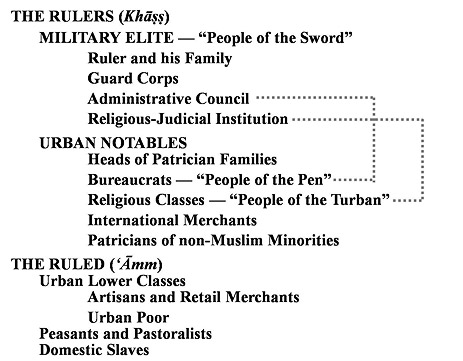Image Resource Bank
Image Gallery |  7 of 15
7 of 15 
The Socio-political Hierarchy of Medieval Islamic Society
Delegation of administrative, judicial, and military responsibilities to subordinates was vital for the efficient and effective maintenance of the Umayyad and Abbasid caliphates, and later the empires of the sultāns. This bureaucratic system created multiple political and social orders of khāss (the rulers) positioned above the lower classes (‘amm, the ruled). We have established that the sultāns attained their political authority through the conquest of territories belonging to the caliph-imām. Even though this military activity undercut the caliph-imām’s authority, many Muslims reasoned that the principles of governance that had guided the historic Sunnī-Jamā‘ī Imamate remained unchanged so long as the sultāns provided for the “equitable maintenance” of the various social classes and guaranteed that each retained its “proper place” and received its “due portion of provision and honor.” Thus, the direct rule of sultāns became a justifiable alternative to the Sunnī-Jamā‘ī Imamate. From this general scheme, we can see the relative status of each class and the outlines of a complex network of military personnel, specialized state functionaries, prominent businessmen, and an influential aristocracy all participating, in various ways, in governance and social management. The diffusion of power across the classes of rulers placed limitations on the sultān’s absolute sovereignty and indicates that urban notables exercised some degree of autonomy and local authority in areas outside the jurisdiction of the imperial capital.
Name: The Socio-political Hierarchy of Medieval Islamic Society
Material: JPEG image
Size: 1430 x 1114 pixels
Date: 2009
Place of Origin: University of Chicago
Location: Chicago, IL
Source and Registration#: Professor John E. Woods

 John Woods
John Woods
Professor of Iranian and Central Asian History, and of Near Eastern Languages & Civilizations
 Alexander Barna
Alexander Barna
Outreach Coordinator, Center for Middle Eastern Studies, University of Chicago




